
Tourism Places In jodhpurMehrangarh Fort 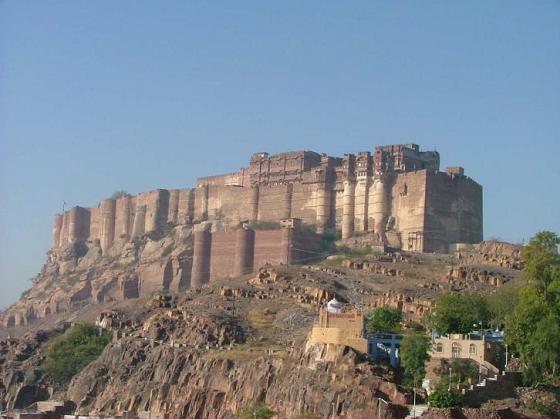 Mehrangarh appears impregnable, and with good reason. Its battlements soar four hundred feet above a hill, that rises sharply from the surrounding countryside. Mehrangarh has its own architectural appeal, such as brilliant stained glass, that creates vibrant mosaics on the floors, with the passage of the sun through the day.
Mehrangarh Fort is One of the finest and most formidable forts in India, the magnificent Mehrangarh Fort is located on a steep 125 m high hillock, graciously overlooking the city. Spread over an area of 5 sq. km, the Fort has seven splendid gates to enter into. Standing as a mute spectator to the splendors of an era replete with chivalry, glory and grandeur, the Mehrangarh Fort houses a number of beautiful palaces like the Phool Mahal, the Moti Mahal and the Sheesh Mahal. The Fort also houses a Museum.
Situated on a steep hill, Mehrangarh fort is one of the largest forts in India. The beauty and the grandeur of numerous palaces in the fort narrates a saga of hard sandstones yielding to the chisels of skilled jodhpuri sculptures. Mehrangarh Fort, spreading over 5 km on a perpendicular hill and looking down 125 meters, presents a majestic view on city horizon.
Dominating the city of jodhpur is Mehrangarh, one of Rajasthan's three great hilltop forts.
This Fort is one of the best in India with its exquisitely latticed windows, carved panels, elaborately adorned windows and walls of Moti Mahal, Phool Mahal, Sheesh Mahal. A collection of musical instruments, palanquins, royal costumes, furniture and the cannons on the fort's ramparts are well preserved.
Mehrangarh appears impregnable, and with good reason. Its battlements soar four hundred feet above a hill, that rises sharply from the surrounding countryside. Mehrangarh has its own architectural appeal, such as brilliant stained glass, that creates vibrant mosaics on the floors, with the passage of the sun through the day.
Mehrangarh Fort is One of the finest and most formidable forts in India, the magnificent Mehrangarh Fort is located on a steep 125 m high hillock, graciously overlooking the city. Spread over an area of 5 sq. km, the Fort has seven splendid gates to enter into. Standing as a mute spectator to the splendors of an era replete with chivalry, glory and grandeur, the Mehrangarh Fort houses a number of beautiful palaces like the Phool Mahal, the Moti Mahal and the Sheesh Mahal. The Fort also houses a Museum.
Situated on a steep hill, Mehrangarh fort is one of the largest forts in India. The beauty and the grandeur of numerous palaces in the fort narrates a saga of hard sandstones yielding to the chisels of skilled jodhpuri sculptures. Mehrangarh Fort, spreading over 5 km on a perpendicular hill and looking down 125 meters, presents a majestic view on city horizon.
Dominating the city of jodhpur is Mehrangarh, one of Rajasthan's three great hilltop forts.
This Fort is one of the best in India with its exquisitely latticed windows, carved panels, elaborately adorned windows and walls of Moti Mahal, Phool Mahal, Sheesh Mahal. A collection of musical instruments, palanquins, royal costumes, furniture and the cannons on the fort's ramparts are well preserved. Umaid Bhavan Palace 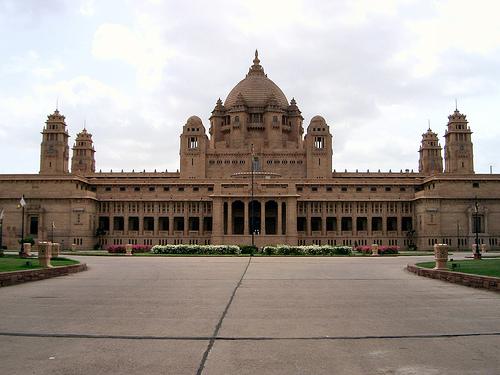 One of the fascinating palaces of jodhpur is the Umaid Bhavan palace. A part of the palace has now been converted into a hotel and a museum.The 20th century Umaid Bhavan Palace was built in a time of peace, and is quite Western in its design. It was built, as a famine relief project, which gave employment to people, for 16 years. Under a dome, the like of which no other palace in Rajasthan can boast of, the Palace contains over 300 rooms. It has its own theatre, eight dining rooms, and a banquet hall which seats three hundred people. A Ball Room had been built, catering to the Westernised royal lifestyle. The romantic looking Umaid Bhawan Palace was actually built with the purpose of giving employment to the people of jodhpur during a long drawn famine. The royal family of jodhpur still lives in a part of the palace.Another part of the palace houses a well-maintained museum, displaying an amazing array of items belonging to the Maharaja and the royal family - weapons, antiques & fascinating clocks, crockery and trophies . Much of the interior of the palace is in the art deco style. In fact, it is said to be one of the finest surviving examples of art deco in the world. Deep within the palace is an indoor swimming pool, with a mosaic of zodiac symbols. The palace now runs as a hotel, though, a part of it has been retained as a museum and part as royal residence.This museum has a rich collection of weapons, textiles, miniature portraits, local crafts and images of Jain Tirthankars. It is situated in the middle of the Umaid public gardens.
One of the fascinating palaces of jodhpur is the Umaid Bhavan palace. A part of the palace has now been converted into a hotel and a museum.The 20th century Umaid Bhavan Palace was built in a time of peace, and is quite Western in its design. It was built, as a famine relief project, which gave employment to people, for 16 years. Under a dome, the like of which no other palace in Rajasthan can boast of, the Palace contains over 300 rooms. It has its own theatre, eight dining rooms, and a banquet hall which seats three hundred people. A Ball Room had been built, catering to the Westernised royal lifestyle. The romantic looking Umaid Bhawan Palace was actually built with the purpose of giving employment to the people of jodhpur during a long drawn famine. The royal family of jodhpur still lives in a part of the palace.Another part of the palace houses a well-maintained museum, displaying an amazing array of items belonging to the Maharaja and the royal family - weapons, antiques & fascinating clocks, crockery and trophies . Much of the interior of the palace is in the art deco style. In fact, it is said to be one of the finest surviving examples of art deco in the world. Deep within the palace is an indoor swimming pool, with a mosaic of zodiac symbols. The palace now runs as a hotel, though, a part of it has been retained as a museum and part as royal residence.This museum has a rich collection of weapons, textiles, miniature portraits, local crafts and images of Jain Tirthankars. It is situated in the middle of the Umaid public gardens.Clock Tower 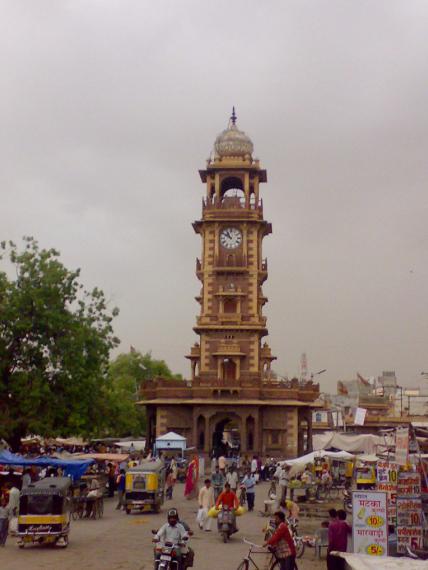 A prime attraction of the city, is the Clock Tower and the colourful Sardar Market near it. Narrow alleys lead to quaint bazaars selling textiles, antiques, silverware and handicrafts.
A prime attraction of the city, is the Clock Tower and the colourful Sardar Market near it. Narrow alleys lead to quaint bazaars selling textiles, antiques, silverware and handicrafts. Osian Rajasthan's largest group of early Jain and Hindu temples lies on the outskirts of the small town of Osian, 60 km from jodhpur. Once a great trading centre, today, the town is a desert oasis, home to numerous peacocks. The largest of the 16 Jain and Brahmanical temples is dedicated to Mahavira, the last of the Jain tirthankars. In the same area the Surya temple has fascinating images of Durga, Surya and Ganesh. Surya or Sun temple and the Sachiya temples are famous for their beauty. The sculptural intricacy of the Osian temples rival that of any of the famous temples of the country, be it the Sun Temple of Konark, or the Hoysala temples of Karnataka. Mandore Garden 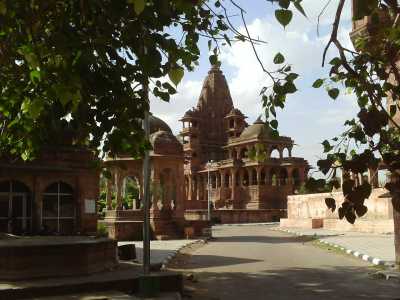 Mandore Gardens is Located at just 9 km from jodhpur, Mandore is famous for its sprawling gardens, massive cenotaphs, temples, ruins and sculpture. A popular picnic spot, the gardens are famous for its manicured lush green lawns, rock-carved sculptures, all from a single piece of stone, and a small museum displaying sculptures and ivory and lacquer pieces.
In the Mandore garden, there are the dewals or cenotaphs of jodhpur's former rulers. Instead of the usual chhatri-shaped cenotaphs typical of Rajasthan, the cenotaphs of the famous Mandore garden of jodhpur, Rajasthan are built along the lines of a Hindu temple. They are four stories high, with fine columns and an elegant spire, all in red sandstone. The most impressive dewal is the dewal of Maharaja Ajit Singh. These cenotaphs are set in beautiful landscaped gardens. The cenotaphs of the Maharani are set on a rocky outcrop over the hill.
Near to the cenotaphs is the hall of heroes. The hall is dedicated to various deities and Rajput folk heroes. The statues of the deities and heroes we are carved out of rock and painted in bright colors. Also in this garden of jodhpur, is "The Shrine of the Three Hundred Million Gods", filled with brightly colored images of the various Hindu Gods. As you climb up the hill, you come to the ruined city of Mandore, with its old palace.
It was the former capital of Maharajas of Marwar. Later it was abandoned for security concerns regarding the Mehrangarh fort. Its extensive Mandore garden, with high rock terrace, makes it a popular local attraction. The garden is open for tourists from 8 am to 8 pm.
Mandore Gardens is Located at just 9 km from jodhpur, Mandore is famous for its sprawling gardens, massive cenotaphs, temples, ruins and sculpture. A popular picnic spot, the gardens are famous for its manicured lush green lawns, rock-carved sculptures, all from a single piece of stone, and a small museum displaying sculptures and ivory and lacquer pieces.
In the Mandore garden, there are the dewals or cenotaphs of jodhpur's former rulers. Instead of the usual chhatri-shaped cenotaphs typical of Rajasthan, the cenotaphs of the famous Mandore garden of jodhpur, Rajasthan are built along the lines of a Hindu temple. They are four stories high, with fine columns and an elegant spire, all in red sandstone. The most impressive dewal is the dewal of Maharaja Ajit Singh. These cenotaphs are set in beautiful landscaped gardens. The cenotaphs of the Maharani are set on a rocky outcrop over the hill.
Near to the cenotaphs is the hall of heroes. The hall is dedicated to various deities and Rajput folk heroes. The statues of the deities and heroes we are carved out of rock and painted in bright colors. Also in this garden of jodhpur, is "The Shrine of the Three Hundred Million Gods", filled with brightly colored images of the various Hindu Gods. As you climb up the hill, you come to the ruined city of Mandore, with its old palace.
It was the former capital of Maharajas of Marwar. Later it was abandoned for security concerns regarding the Mehrangarh fort. Its extensive Mandore garden, with high rock terrace, makes it a popular local attraction. The garden is open for tourists from 8 am to 8 pm. Balsammand Lake & Palace 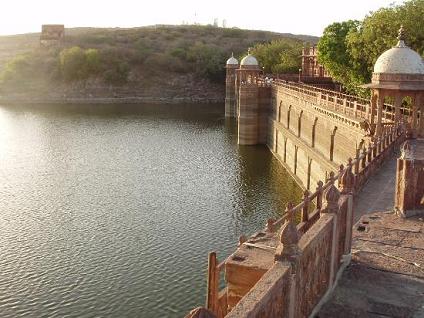 Balsamand Lake and Palace is Located at only 7 km from jodhpur, the beautiful Balsamand Palace is the erstwhile summer palace on the embankments of a serene and calm Balsamand Lake.
Many a times you must have dreamt of staying in a huge, royal palace on the sea-shore or on the banks of river or if not both at least a palace facing the water reservoir. There is such a place at Mandore in Rajasthan .The 19th Century sandstone palace built on a hillock facing Balsammand lake is one of such places that's definitely going to win your heart.
The palace was created by Maharajah Sur Singhji, as a summer pavilion. It is very finely carved with latticed windows that allow the soft, cool breeze to blow into the interiors of the palace. The embankments of the lake, in front of the palace, have domed structure that offers fabulous views of the lake encircled by hills. An artificial cascading waterfall, brings water down from the reservoir to the gardens. Mandore, is a part of jodhpur but it enjoys the calmness by being far from the city crowd.The rooms and suites, the entire ambience here makes one feel as if you are staying in a royal palace. One can even enjoy a walk through the trees, the rose beds, pools covered with lilies and the groves of mango, plum, banana, pomegranate and so on. One will also get to see the peacocks, blue bulls, jackals and hundreds of flying foxes in the trees.
Balsamand Lake and Palace is Located at only 7 km from jodhpur, the beautiful Balsamand Palace is the erstwhile summer palace on the embankments of a serene and calm Balsamand Lake.
Many a times you must have dreamt of staying in a huge, royal palace on the sea-shore or on the banks of river or if not both at least a palace facing the water reservoir. There is such a place at Mandore in Rajasthan .The 19th Century sandstone palace built on a hillock facing Balsammand lake is one of such places that's definitely going to win your heart.
The palace was created by Maharajah Sur Singhji, as a summer pavilion. It is very finely carved with latticed windows that allow the soft, cool breeze to blow into the interiors of the palace. The embankments of the lake, in front of the palace, have domed structure that offers fabulous views of the lake encircled by hills. An artificial cascading waterfall, brings water down from the reservoir to the gardens. Mandore, is a part of jodhpur but it enjoys the calmness by being far from the city crowd.The rooms and suites, the entire ambience here makes one feel as if you are staying in a royal palace. One can even enjoy a walk through the trees, the rose beds, pools covered with lilies and the groves of mango, plum, banana, pomegranate and so on. One will also get to see the peacocks, blue bulls, jackals and hundreds of flying foxes in the trees.
Rai-ka-Bag Palace This palace is situated near Raika Bag palace railway station. It was constructed in 1663 by Hadiji, queen of king jaswant Singh-I. King Jaswant Singh-II liked this palace very much. He mostly stayed in the octagonal bunglow of this palace. In 1883 when Swami Dayanand Saraswati came to jodhpur, his sermons were arranged for the public in the public ground of this palace. Even Jaswant Singh used to listen to Swami Dayanand in this palace only. Now income tax office functions in this palace. Guda Bishnoi 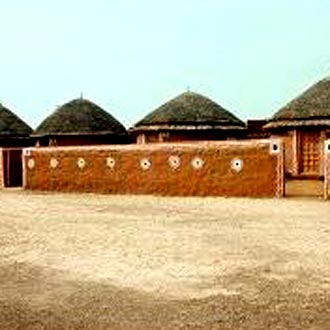 This village is inhabit ated by the Bishnoi community. They are staunch believers in the sanctity of plant and animal life. Villages are marked by Khejri trees and deers which thrive.
This village is inhabit ated by the Bishnoi community. They are staunch believers in the sanctity of plant and animal life. Villages are marked by Khejri trees and deers which thrive.Government Museum jodhpur Government Museum of jodhpur, Rajasthan is situated on the High Court Road. It stands in the middle of the Umaid public gardens. The museum building and the garden were developed during the time of Maharaja Umaid Singhji. It encompasses a wide collection of weapons, textiles, miniature portraits and local arts and crafts. Also displayed in the museum are, portraits of rulers and the manuscripts and images of Jain Tirthankars. Rajasthan's popular Government Museum also has a public library and a zoo, located in the pleasant Umaid Gardens. The museum holds a special attraction for kids. Children get very excited by the sight of stuffed animals, including a number of desert birds in two glass cases, each with a thorn bush. There is also a military section, exhibiting cumbersome wooden biplane models and an extraordinary brass battleship. Jaswant Thada 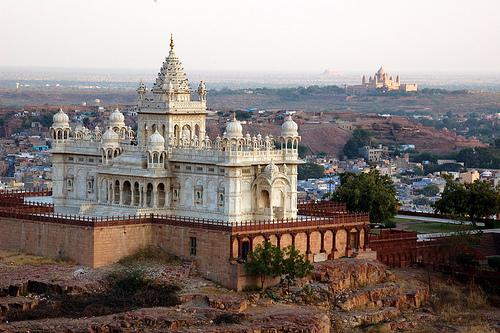 Jaswant Thada lies to the left of the Mehrangarh fort complex. It is a royal cenotaph made up of white marble. It was built to commemorate Maharaja Jaswant Singh. Some rare portraits of the former rulers of jodhpur are also displayed here.
This 19th century royal cenotaph built in white marble in commemoration of Maharaja Jaswant Singh II and three other cenotaphs, stand nearby. The cenotaph of Maharaja Jaswant Singh holds the rare portraits of the rulers and Maharajas of jodhpur. A visit inside the cenotaphs, with some villagers of the region, would bring forward the reverence they still hold for their brave kings.
Jaswant Thada lies to the left of the Mehrangarh fort complex. It is a royal cenotaph made up of white marble. It was built to commemorate Maharaja Jaswant Singh. Some rare portraits of the former rulers of jodhpur are also displayed here.
This 19th century royal cenotaph built in white marble in commemoration of Maharaja Jaswant Singh II and three other cenotaphs, stand nearby. The cenotaph of Maharaja Jaswant Singh holds the rare portraits of the rulers and Maharajas of jodhpur. A visit inside the cenotaphs, with some villagers of the region, would bring forward the reverence they still hold for their brave kings. Famous Temples of jodhpur: Chamundaji Temple Ganesh Temple Raj Ranchhodji Temple Achal Nath Shivalaya Siddhanth Shiv Temple Rasik Bihari Temple Baba Ramdeo Temple Udai Mandir Mahamandir Temple Kunj Bihari Temple Chamunda Mataji Temple 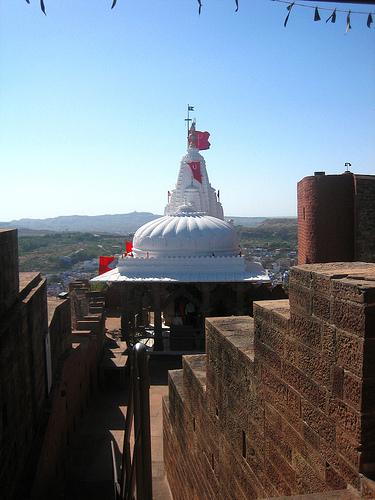 The Chamunda Mataji Temple in jodhpur is situated in the southern end of the Mehrangarh Fort. Chamunda Mataji was the favorite goddess of Rao Jodha. In 1460, he brought her idol from the old capital of Mandore in 1460. Then, it was installed in the Mehrangarh Fort. Till date, the goddess remains the Isht Devi (the adopted goddess) of Maharajas and the Royal Family.
Chamunda Mata is worshipped by most of jodhpur's citizens also. During Dussehra celebrations, Mehrangarh Fort is thronged by devotees to get a glimpse of Chamunda Devi. If you are a devotee of Chamunda Devi, do visit this temple, when in jodhpur.
The Chamunda Mataji Temple in jodhpur is situated in the southern end of the Mehrangarh Fort. Chamunda Mataji was the favorite goddess of Rao Jodha. In 1460, he brought her idol from the old capital of Mandore in 1460. Then, it was installed in the Mehrangarh Fort. Till date, the goddess remains the Isht Devi (the adopted goddess) of Maharajas and the Royal Family.
Chamunda Mata is worshipped by most of jodhpur's citizens also. During Dussehra celebrations, Mehrangarh Fort is thronged by devotees to get a glimpse of Chamunda Devi. If you are a devotee of Chamunda Devi, do visit this temple, when in jodhpur.
Siddhnath Siddhnath Shiv temple is located between Takhat Sagar hills. On the road going from the right of filter house on jodhpur-Chopasani Road, on crossing the stairs made by cutting rocks, one can reach Siddhnath temple. Many years ago it was an absolutely deserted place. And because of that, a hermit Veetragi Narain Swami started staying here. He was a highly worshipped and respected saint, known in the nearby areas. Once a handicapped saint named Gaurishanker, later known as Nepali Baba, came to this place. He had only four fingers in each of his hand and foot. He made a big temple by cutting stones, which is now known as Siddhnath. Ganesh Temple The area which is called Ratanada was named after a dog called Rata. About 150 years ago a teacher Radidas in a place called Gorunda saw a statue of Vinayakji in the hills of Ratanada. The statue is eight feet high and five feet wide. Mahamandir Temple 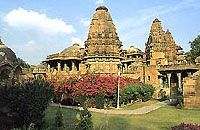 Mahamandir Temple is Located at just 2 km from jodhpur on the Mandore Road, the Mahamandir Temple is famous for its 84 intricately carved pillars, ornamented with detailed carvings of yogic postures.
Mahamandir Built in 1812, this is a small walled town, clustered around a 100-pillared Shiva temple.
Mahamandir Temple is Located at just 2 km from jodhpur on the Mandore Road, the Mahamandir Temple is famous for its 84 intricately carved pillars, ornamented with detailed carvings of yogic postures.
Mahamandir Built in 1812, this is a small walled town, clustered around a 100-pillared Shiva temple.Raj Ranchhodji Temple It was made by queen Jadechi Rajkanwar after the death of her husband, king Jaswant Singh. Major Part of the temple is made of red sandstone, carved with beautiful filigree work. The heart of the temple has the statue of Ranchhodji made of black marble.It has green, yellow and blue glassess fixed on its main door. Achal Nath Shivalaya Achal Nath Shivalaya was constructed by Nanak Devi, queen of Rao Ganga. The construction was completed on 21st May 1531. A large water reservoir called Bawari was made near the Shivlinga which is known as Ganga Bawari. The Garbh Griha, Mandap and Kirtan Bhawan of the temple are made of carved Chhitar stone. Umaid Bhavan Palace Museum 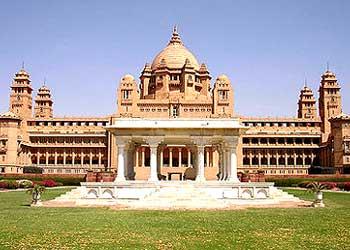 Maharaja Umaid Singhji was very fascinated by western lifestyle. So, he hired the services of a well-known Edwardian architect, Henry Vaughan Lanchester to get Umaid Bhavan palace constructed. A part of the palace now houses the Umaid Bhavan Palace of jodhpur, Rajasthan.
The museum is very well maintained, displaying an exclusive range of items belonging to the Maharaja and the royal family. Rajasthan's famous Umaid Bhavan Palace Museum is highly recommended for its display of items ranging from weapons to an array of stuffed leopards to antiques to some fascinating crockery to various trophies. Also exhibited is a huge banner presented by Queen Victoria and an amazing collection of clocks.
Maharaja Umaid Singhji was very fascinated by western lifestyle. So, he hired the services of a well-known Edwardian architect, Henry Vaughan Lanchester to get Umaid Bhavan palace constructed. A part of the palace now houses the Umaid Bhavan Palace of jodhpur, Rajasthan.
The museum is very well maintained, displaying an exclusive range of items belonging to the Maharaja and the royal family. Rajasthan's famous Umaid Bhavan Palace Museum is highly recommended for its display of items ranging from weapons to an array of stuffed leopards to antiques to some fascinating crockery to various trophies. Also exhibited is a huge banner presented by Queen Victoria and an amazing collection of clocks.Nehru Park jodhpur Nehru Park is another one of the popular gardens of jodhpur. The park is covering an area of 14 acres. Nehru Park was developed as a park for children. The famous Nehru park of jodhpur, Rajasthan was inaugurated on 7th September 1966 by the then Chief Minister, Shri Mohan Lal Sukhadia. The park reflects the beauty of nature through its fountain, pond, swings, flowerbeds, trees and plants, etc. Earlier there was a pond named Bakhat Sagar pond. But slowly and gradually the pond deteriorated with the city's dirty water getting collected there. In order to solve the problem, its upper portion was converted into Bakhat Sagar residential colony. The lower portion of the pond contains the Nehru park now. Jaswant Sagar Dam In 1892, Maharaja Jaswant Singh constructed Jaswant Sagar in Pichiyak village between Bilara and Bhavi of jodhpur district.The Water from this dam is used for irrigating the greenest part of jodhpur receives water from this dam. Boating facilities have also been made available for tourists here. |

